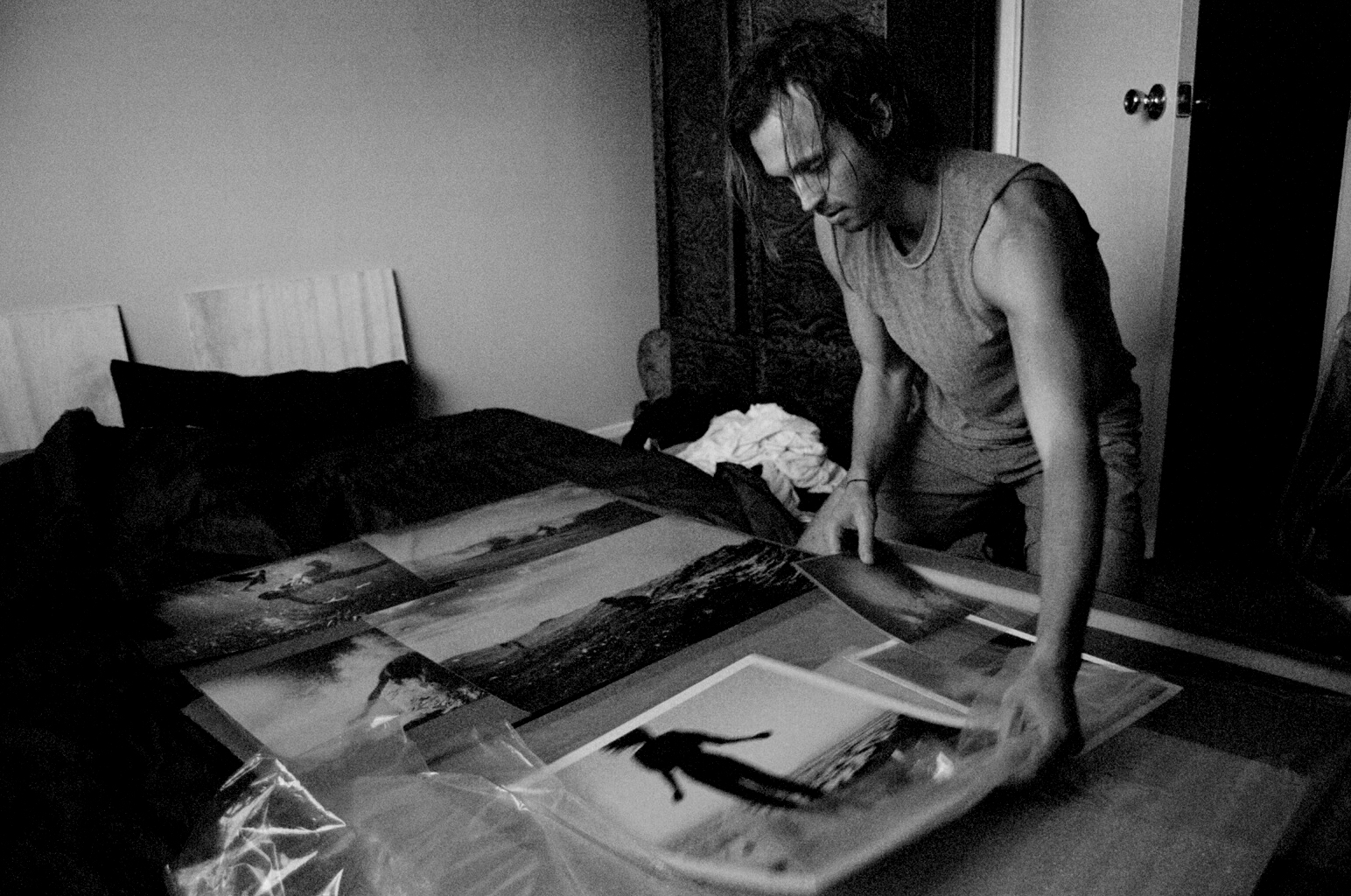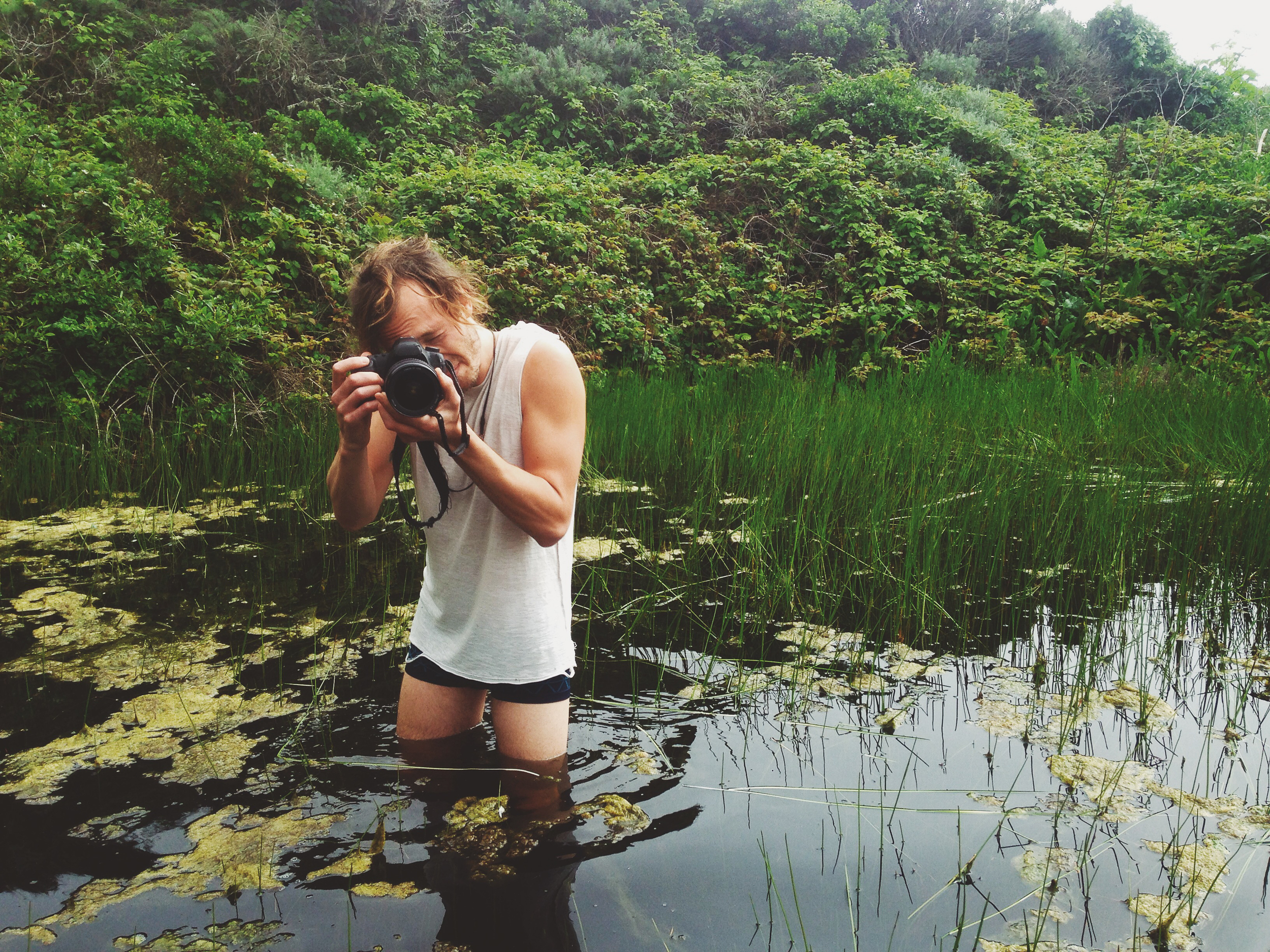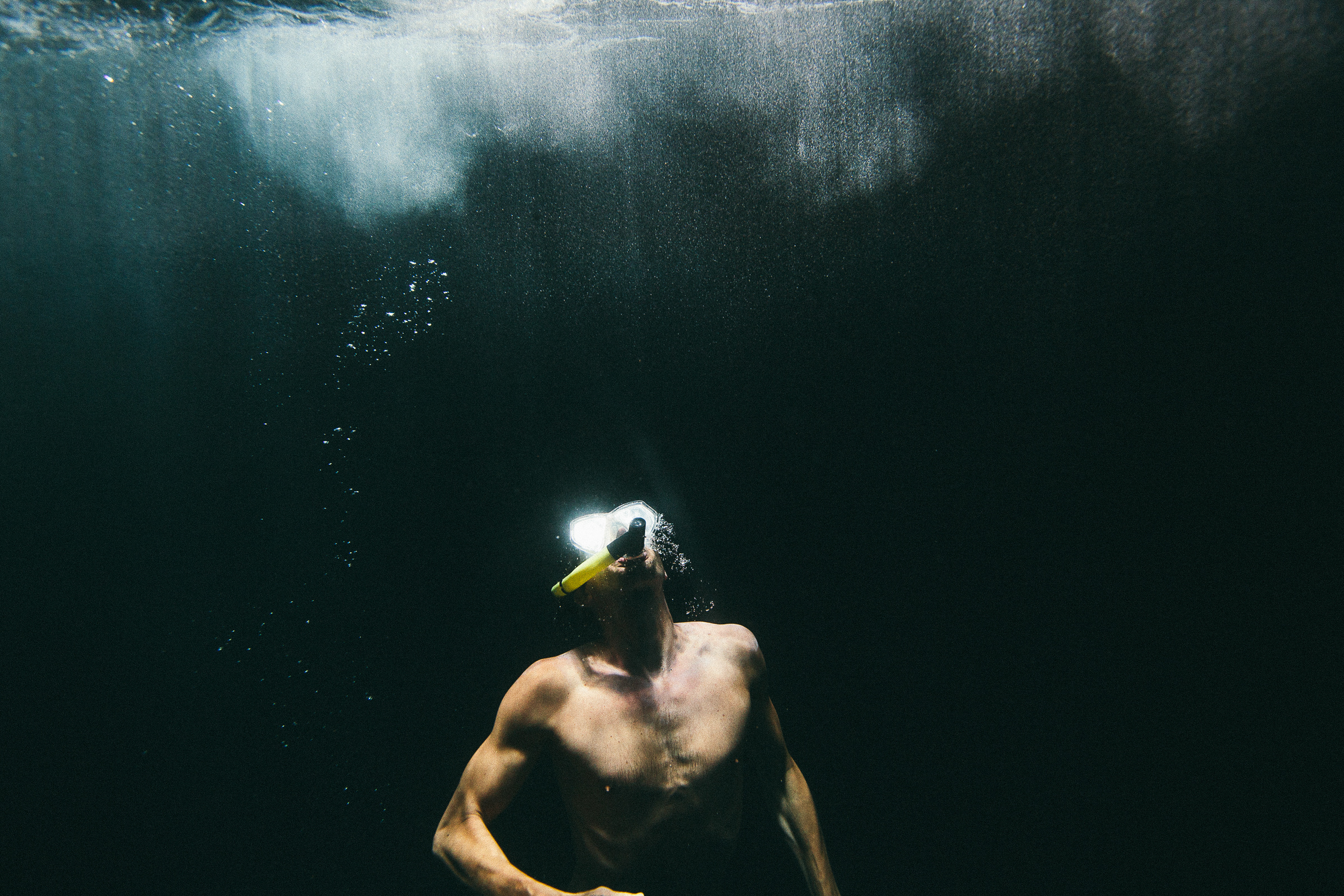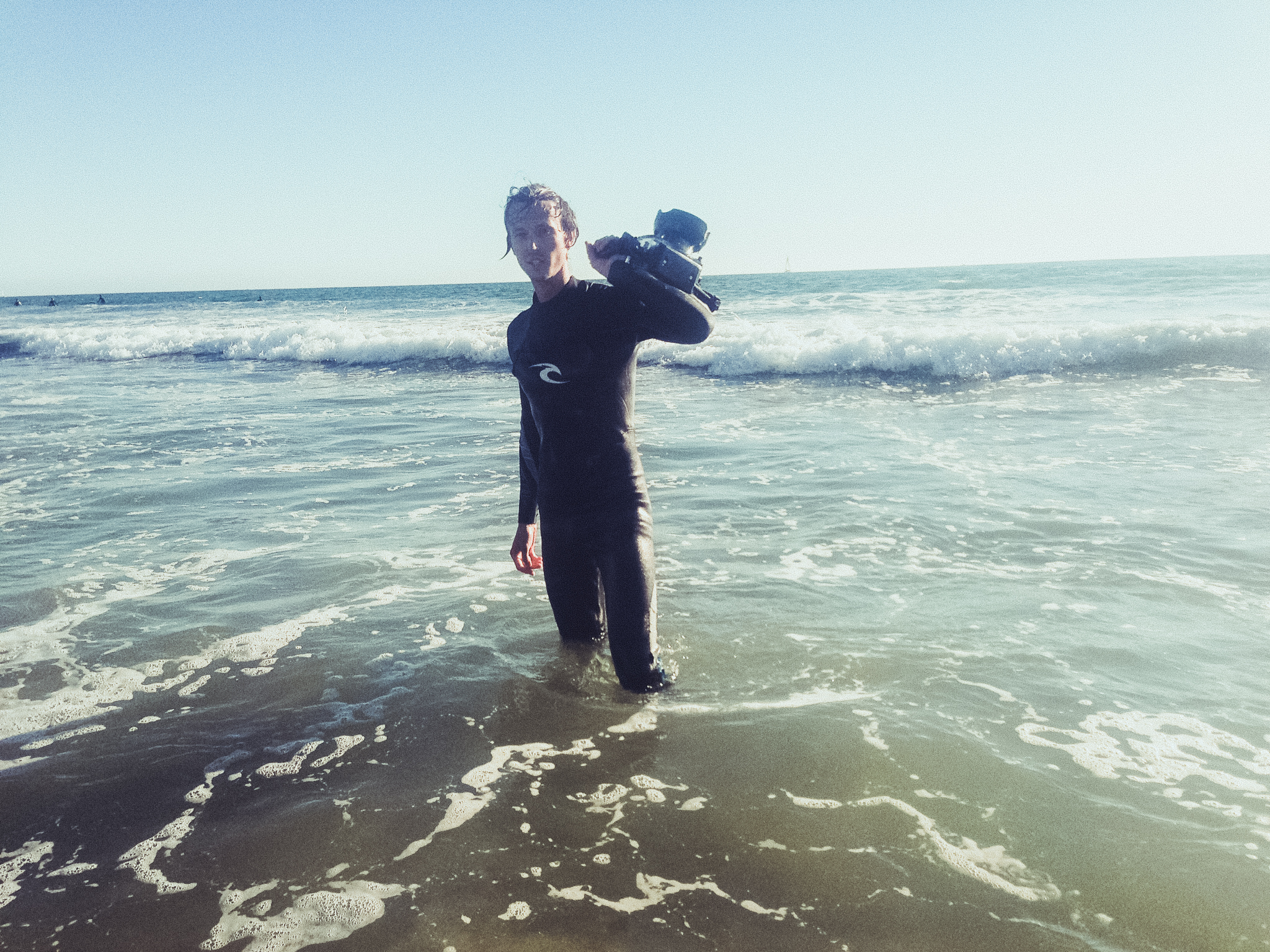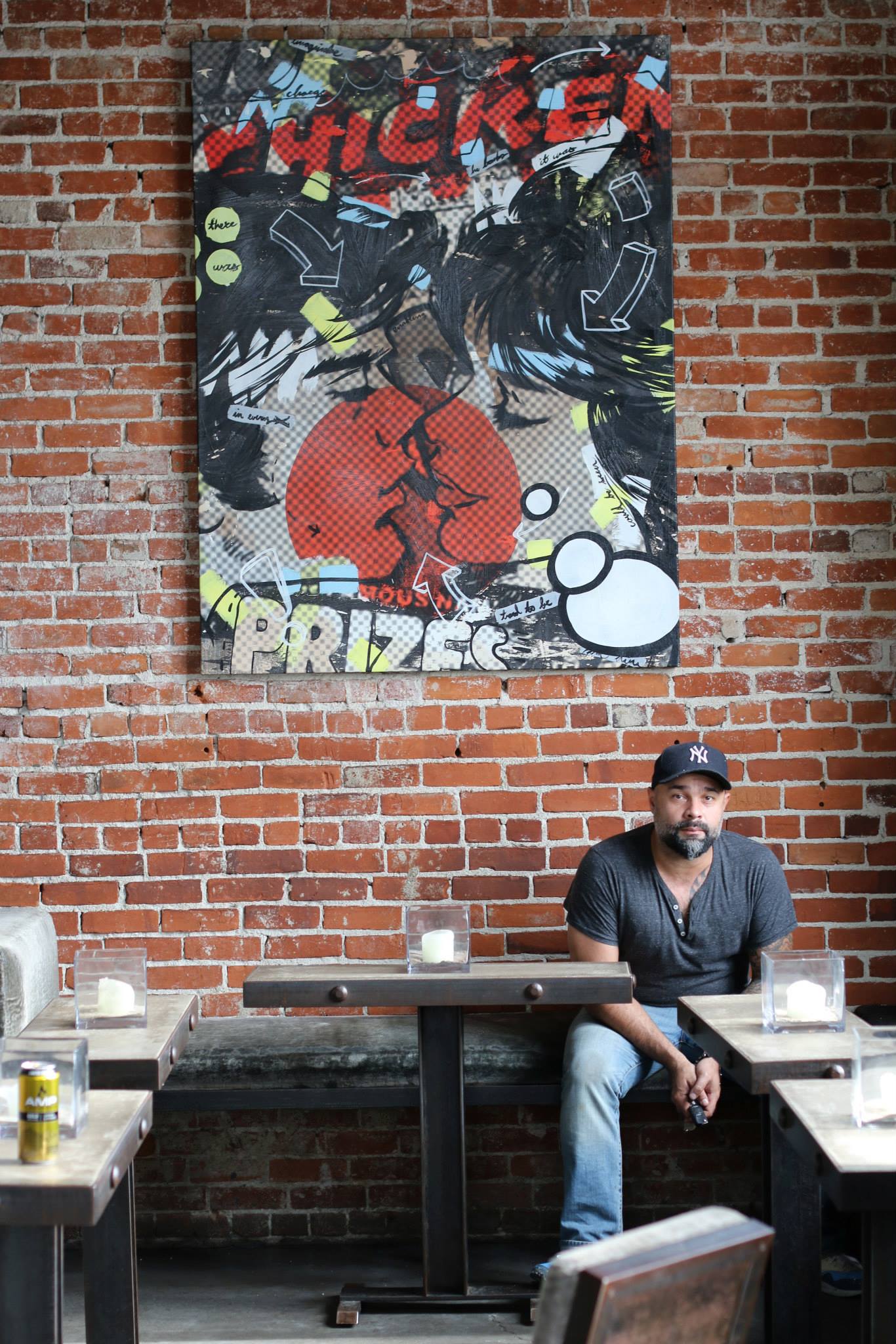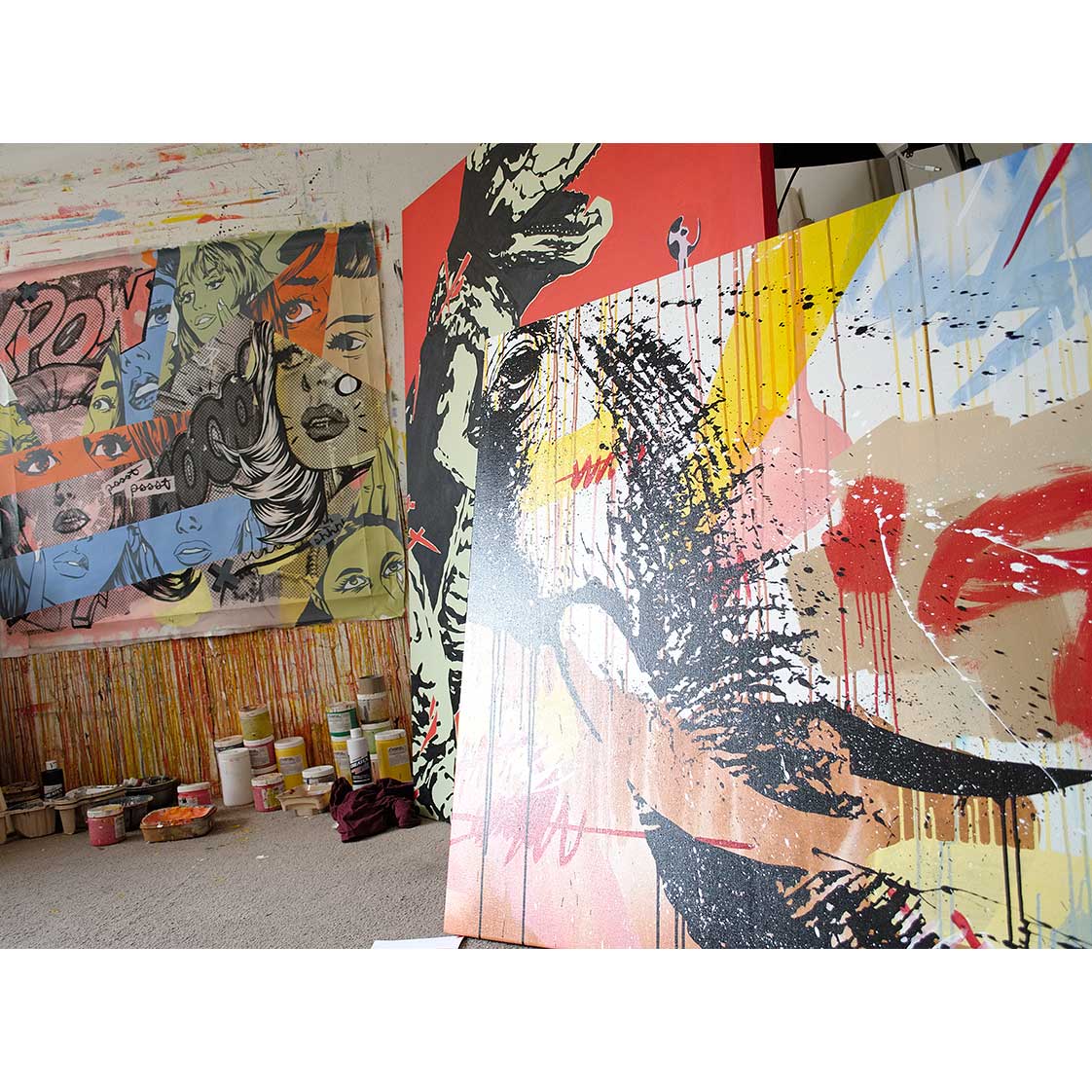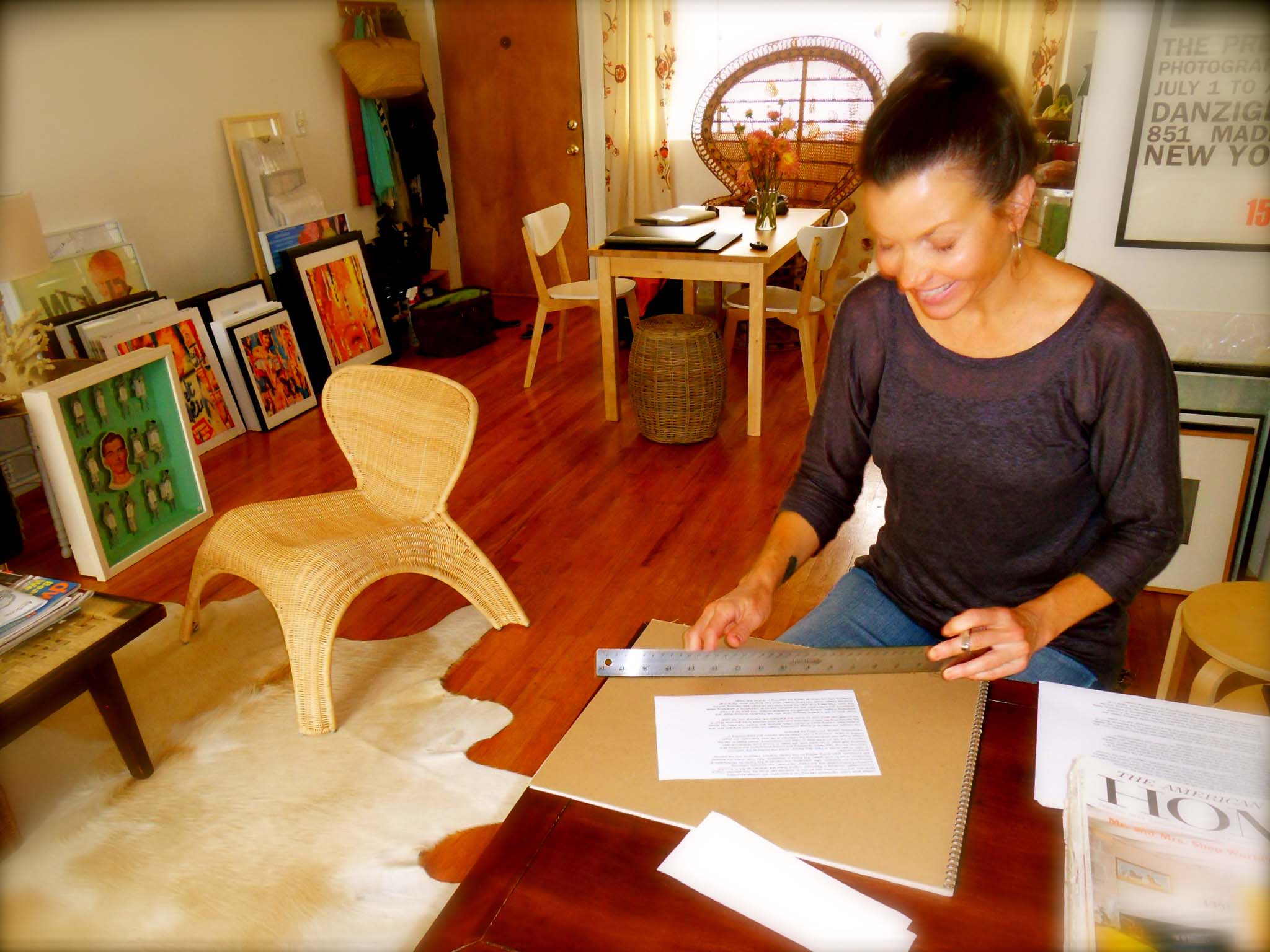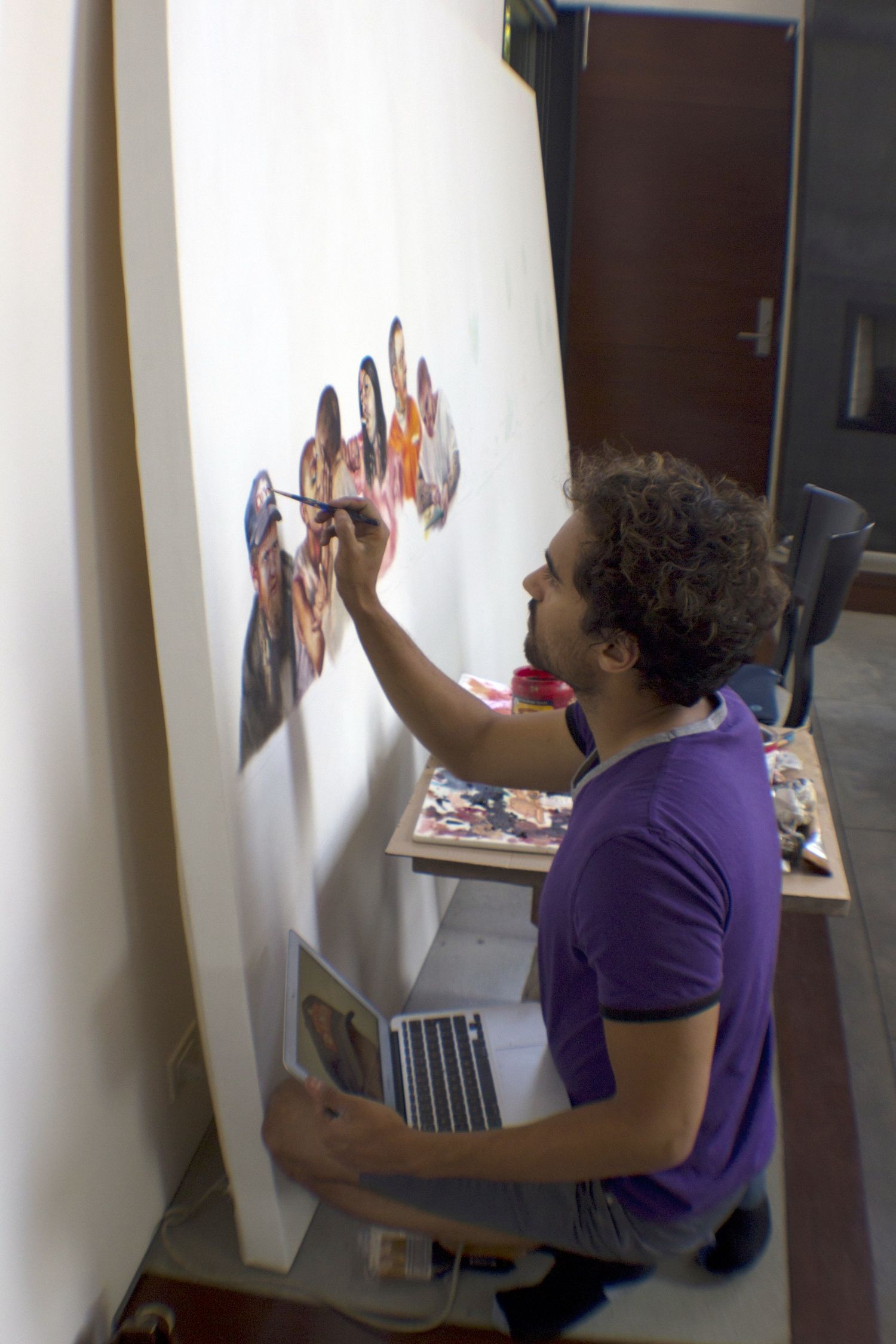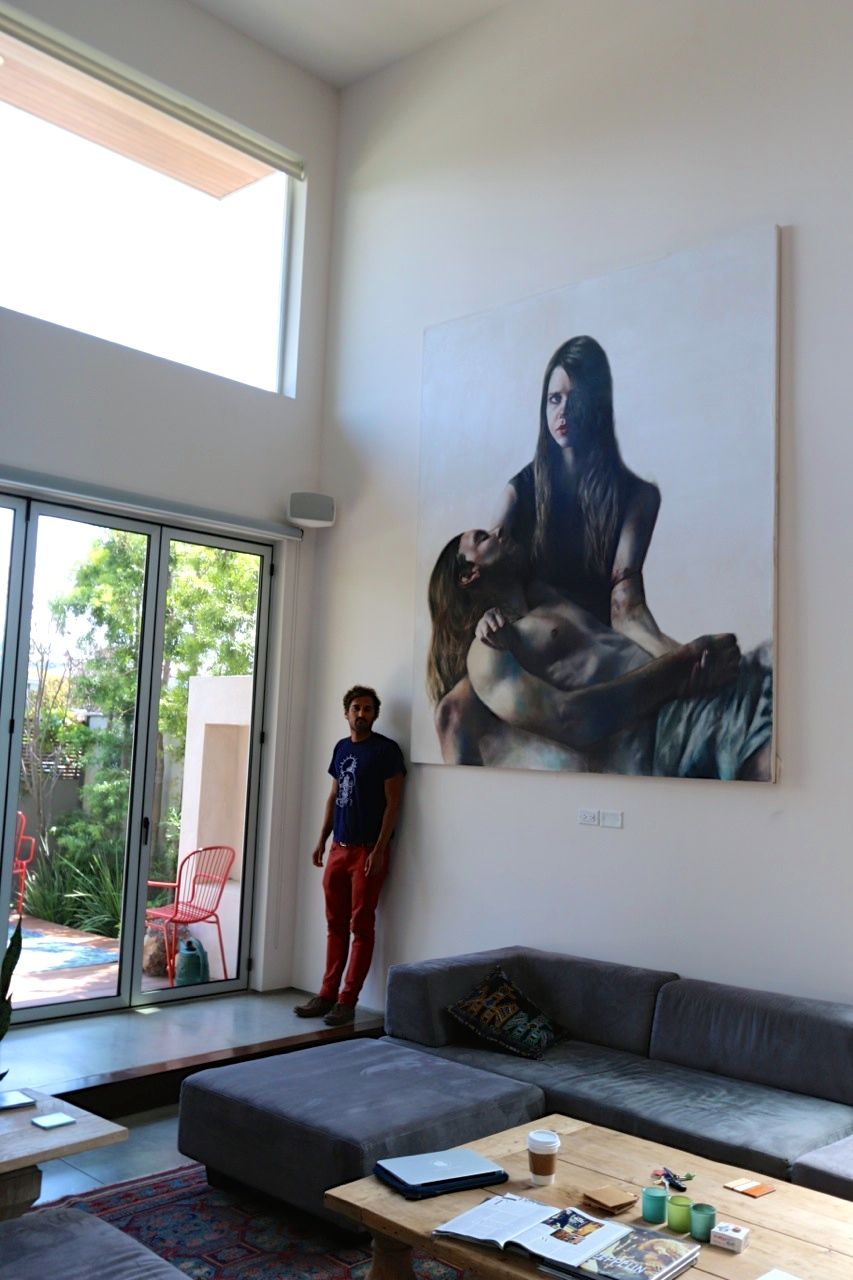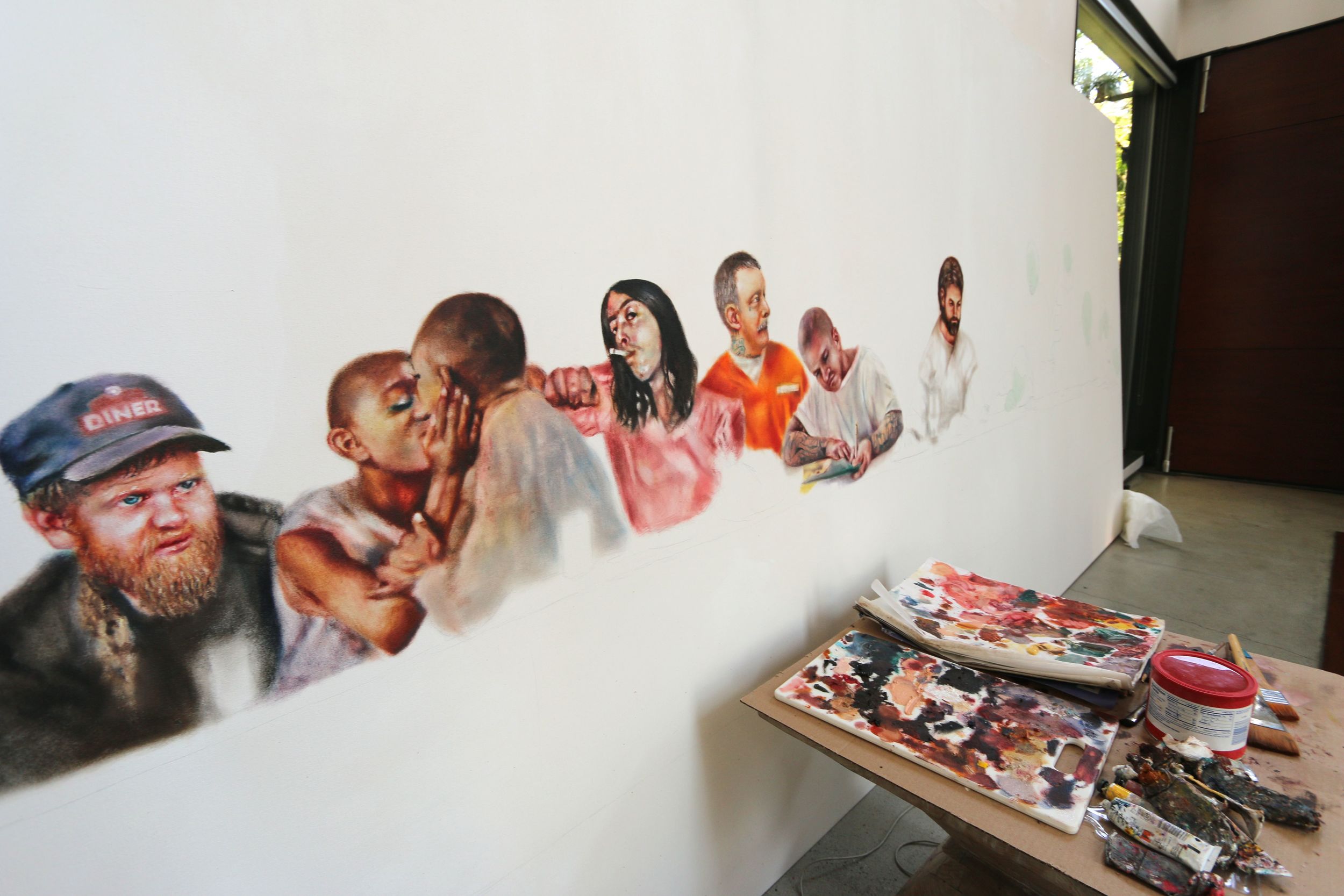Viewing entries tagged
inside the artist's studio
Art Unified artist Daniel N. Johnson is part-time nomad and full-time sage, by way of 35 countries. What initially began as a means of sharing his experiences abroad with family and friends soon turned into a photographic aesthetic characterized by the most beautiful dualities: waxing and waning, inhaling and exhaling, ocean and desert. This masterful play on the emotional duplexity of his viewers is precisely the wonder of this artist: by submerging them into a foreign world of refracted light and disorienting darkness, his viewers emerge from each viewing at the height of awareness of the solid ground beneath their feet and a steady rhythm of breath. To capture the emotional shore between the world we know and how we'd like to know it is no easy task, but Johnson's grasp of ephemera and quick lens makes this transient meeting ground somehow seem, for a moment, inhabitable. Read on to see what Art Unified's favorite wayfarer had to say about Chuck Close, his disciplined morning routine, and hitchhiking between Poland and Turkey.
"I'm continually drawn to shoot either in water or the desert - for me both environments lend themselves to equal parts absence and fullness."
Art Unified: What drove you to want to become an artist?
Daniel N. Johnson: I think it’s because I wanted to share the way that I saw the world with others. That may be a clichéd a response as a photographer but it’s definitely one of my initial motivations - to find a way for other people to experience the beautiful or unique things I felt I discovered in life.
As an introverted and shy kid, visual expression was the easiest way for me to communicate. That pathway began in drawing, then led eventually to graphic and web design, motion graphics/animation, and now, photography.
It also became evident while traveling solo internationally. I’d have these incredible experiences which I felt slightly guilty to encounter all alone. I wanted to share my adventures with my friends and family and the camera became the most evident tool to do so, as well being as a wonderful vehicle to interact with other people.
AU: Are there aspects of the art world that you do not approve of? Did any of those reasons lead you to move towards Art Unified?
DNJ: I’m not much a fan of the generic art opening experience - white walls, white wine and the gathering of who’s who, where it’s more about the social event and posturing and less about the interaction or confrontation with the art. What I ultimately want to do is create an experience around the presentation of my art, where you can’t leave without being viscerally affected by it, and leave resonating with your reaction to the work.
I like that Art Unified is actively figuring out ways to put their artists’ work into public spaces where people who wouldn’t necessarily find themselves within the aforementioned white walls of a gallery can interact with new art.
AU: What was your first camera? Do you still use it today in your work, or do you prefer another setup?
DNJ: When I was maybe 7 or 8 my mom gave me a Vivitar 110 automatic film camera (one of those that look like an ice cream sandwich) so I could photograph my Legos. I photographed everything extremely close, imagining that I was capturing giant macro shots of my creations. However, the focal distance on the lens was about 2 or 3 feet so all my images came back as blurry messes. Maybe those were just my abstract years :)
In college I was studying graphic design but I needed a camera for a Photo 101 course. My uncle, who was a photojournalist and my initial photography mentor, gave me his old 35mm manual Nikon FM SLR. Unfortunately the camera broke several years later but I gave it back because it was very nostalgic for him.
I shoot mostly digital these days with a Canon 5D Mark II, but have recently been experimenting with medium format again - Hasselblad 500 series and a twin-lens reflex Seagull.
"When I was maybe 7 or 8 my mom gave me a Vivitar 110 automatic film camera so I could photograph my Legos. I photographed everything extremely close… however, the focal distance on the lens was about 2 or 3 feet so all my images came back as blurry messes. Maybe those were just my abstract years."
AU: What research has gone into the exploration of your artwork?
One of my main traits as a photographer, and probably as a person also, is an empathy for what is. I like to find my subject and potential locations and maybe give some direction but other than that I want to give minimal interference. Even though some of my work is slightly surreal I want it to still be honest - not manipulative, even in how I edit or process my imagery. I used Photoshop 5 years before I ever even took a photo class, so I knew how to create/manipulate other people’s images before I knew how to properly capture my own. As my experience with photography grew I tried to avoid any manipulation beyond the basics of color temperature/exposure/levels, etc
Initially everything starts with either my own experiences or the art I’ve been exposed to in the past. For me it’s more about the emotion I want to capture- so my research is a perpetual life search for reference or inspiration that speaks to that. It may be a quote, a piece of music, or a painting that conveys what I’m hoping to achieve.
AU: What are some of your favorite artists? How does your artwork relate and/or differ?
DNJ: My top three currently are James Turrell, Chuck Close and Ryan McGinley.
I love Turrell for how he explores light and forces his viewers to become more aware of their own perception - to see themselves seeing; the way that he makes us aware of light itself rather than just what light reveals. My own best images seem to usually have an element of that - the way that light reflects off my lens or on my subject, it takes on its own characteristic as a subject in the image and not just as the source of illumination. My early work especially had a lot of lens flare, shooting directly into the sun or other light sources. Turrell’s recent exhibition at LACMA was profoundly moving for for me and was a realization that I’d already been subconsciously exploring the same thing, albeit in a different medium.
I love the honest way that Close captures the human face and the essence of his subjects, very true to their flaws, to what is, but presented in a larger than life format. Staring into a face that's 6 or 7 feet tall forces you into a new relationship with his work. It’s both intimate and intimidating at the same time but ultimately it forces you to view the subject differently, and I think, to see yourself differently as well. I took some self-portraits a couple months ago to capture my own face in a close, uncomfortable large way, that filled the frame. We always want to present ourselves in a very idealized form and instead it forced me to present myself as I was, honestly in the moment. Anyway, Close’s inspiration is more aspirational - I want to make larger scale prints, to find a way to present vulnerabilities and flaws in a beautiful way. Also, whether he’s painting or photographing there is a continuity to his work as he deconstructs and reconstructs his subjects' visages.
And finally McGinley for how he captures a very raw human, energy in his subjects, he taps into the essence of youth and freedom- it’s a feeling that I attempt to capture and convey as well and thus I feel a kinship with him and with his work. He also appears to navigate seamlessly between commercial and personal work while maintaining his integrity as an artist, something that I admire.
AU: What is your studio or preferred place of work, what is it like working there?
DNJ: When I’m on the computer I need a visually quiet space. It’s difficult to work in coffee shops for example because there’s too much visual noise with people constantly moving about. I’ve been pretty nomadic the past few years so I’m still working on developing my ideal work setup - currently I work mostly from home and have a standup desk with an external monitor for my laptop and then everything else just gets spread out from there. I also like having indirect light, air-flow and plant or two to feel some life in the room.
My preferred place to shoot, however, is in a type of environment that is at the same time both contextual and context-less, so the desert or the ocean tend to be two places that continually draw me. I love shooting underwater because while you may be aware that you’re suspended in water, you’re still not quite sure what is happening. Or shooting in the desert, in a barren situation. In both places the light reflects and refracts differently and in sometimes unpredictable ways.
AU: Are there particular habits you have while you work?
DNJ: If I’m shooting it’s to make sure I’m well hydrated and have trail mix or an energy bar at hand. When I’m working on the computer I try to turn off my wi-fi and put my phone on airplane mode for one hour sessions to really get in the flow. I’m a bad multi-tasker and having internet access only exacerbates that if I get distracted.
I also try to be really aware of my breath. There’s a particular pattern that my breathing takes when I’m in the zone and focused. If my breathing is shallow it usually means I’m distracted and not present.
"I used to feel so paralyzed by the sheer amount of things I wanted to do in life - in college I had the wish that I could lead four separate lives simultaneously."
AU: What is one of your favorite quotes or piece of advice you have been given towards being an artist?
DNJ: “It’s not difficult to make things. What’s difficult is getting to the state where you can make things.” - Constantin Brançusi
AU: Did you ever think you would be anything else but an artist?
DNJ: I used to feel so paralyzed by the sheer amount of things I wanted to do in life. In college I had the wish that I could lead four separate lives simultaneously. The first was to follow the path of being a graphic designer, which is what I studied and ultimately began my career as. The second was to be a fine artist - a painter or printmaker. The third was to be a rockstar, and finally the fourth was to be something completely random like a shepherd in New Zealand, to have a very separate quiet introspective, almost monk-ish life.
However, I knew early on that I would work in a creative field of some sort. It may have taken me a while to take on the role of, or at least acknowledge myself as, an artist but from the age of 15 I knew I was going to be a graphic designer. Then I wanted to be a film director. Ultimately I landed in interactive design and motion graphics and out of that spun my current focus on photography.
AU: What has someone said about your artwork that resonates with you today?
DNJ: That I’m able to capture the essence of my subjects, enabling them to see themselves as they never have before. And to enable others to see the subjects as they never have before as well.
AU: How do you go about managing your time between your creative and personal life?
DNJ: There’s not much distinction - I’m always collecting inspiration, every book that I read or piece of music I listen to, every film or video I see, every conversation, etc. Most of my subjects are my friends. If I know you and we spend any amount of time together, the likelihood of you showing up in my art is very high.
That raises the question though - is art my life or is my life my art? I feel like all my life experiences are interpreted through the possibility of being part of something I eventually create. That mindset definitely helps for weathering difficult situations. For example, the best travel stories are usually the ones that weren’t the most pleasant at the time to experience.
However, when it comes to working, I’m a bit of a hermit if I get really focused. So when I try to separate my creative and personal lives, usually one or the other suffers. I can get too focused and only be working, or conversely I spend too much time hanging out with people and not enough time creating. The balance for me is usually found over a longer period of time rather than on a daily basis.
"Most of my subjects are my friends. If I know you and we spend any amount of time together, the likelihood of you showing up in my art is very high. That raises the question though - is art my life or is my life my art?"
AU: Have you taken part in a spiritual journey or means of travel to improve or change your perspective of art? What did you discover?
DNJ: Travel has been one of the most important influences of who I am as a person and consequently as an artist. From inspiring me to pick up a camera in the first place, to share my experience with others, to seeing the world as more than just my own felt experience. The majority of my travels have proved to me the interconnectedness of humanity, despite differences of culture, language, religion, etc.
After college I hitchhiked from Poland to Turkey, hitting about 17 countries in the process - a life-changing trip that forced me to confront a lot of my stereotypes and assumptions about other humans, as well as of myself and what I was capable of.
What I’m searching for in my photography is always something a bit ephemeral, attempting to discover or capture something that’s deeper than simply what is being shot or what is initially evident. From an artistic standpoint it’s about recognizing that the mountain is not "just a mountain” and the ocean is not “just the ocean’ but it’s the potential metaphor. . And in the same way I think that spirituality is also about awareness and perception, and the framework by which you interpret sensory input.
AU: What has your experience been with Art Unified? How did you get involved with Art Unified? How has your experience been with us so far?
DNJ: I first met Johan a little over a year ago at his Generation of War show. He had painted a portrait from a photo of mine that I’d taken in D.R. Congo shooting for Falling Whistles. Later that summer we crossed paths in Venice and he told me about his new business idea and asked me to submit a bio and some images - so I guess I was one of the original Art Unified artists, despite the fact that I dragged my feet a bit in finally submitting my work.
It’s been a great experience - Art Unified has consistently shown enthusiastic support for my work and were responsible for my first public showing in LA, helping me get some of my largest prints made to date.
AU: When you’re working, what does a typical day look like for you?
DNJ: I’m not a morning person but ironically the most consistent part of most days are my mornings. I wake up, do 15 mins of stretching and yoga, 20 minutes meditation, 75 pushups, make breakfast and coffee, then I try to write at least three pages in my notebook (a discipline I picked up from The Artist’s Way) all before I first check my phone or email.
After that I usually try to make a list of the things I need to do or intend to do during the day. Other than that, every day is different. Edits. Emails. Research. or shooting. I’ve gotten back into drawing again lately and usually try to make a minimum 5 drawings throughout the day as well.
AU: I’ve heard from Patrick and Johan that you travel often for your work. What are your favorite places to shoot, and is there a particular destination you’ve been hoping to shoot sometime in the near future?
DNJ: In spite of all my travels I don’t think I’ve shot or discovered my most favorite places yet. However, top on my list yet to visit are Mali, Iran, Madagascar, and Palau.
Two places I'm continually drawn to shoot in are either in water or the desert- for me both environments lend themselves to a equal parts absence and fullness. So living in Los Angeles, Venice Beach and Joshua Tree tend to be fairly consistent locations for me. But California is just an incredibly generous state in terms of it’s geographic diversity.
The past few years I've also spent a bit of time in Utah, which is also one of the most photogenic states in the U.S. I’ve done a lot of my underwater work in Central America. My favorite country though would have to be Ethiopia and I'm hoping to get back there later this year.
"What I ultimately want to do is create an experience around the presentation of my art, where you can’t leave without being viscerally affected by it, and leave resonating with your reaction to the work."
Learn more about Daniel N. Johnson and purchase his original artwork at his Artist page. Head over to the Print Store to buy a giclée print by Johnson.
Every artist is a storyteller, but what makes Art Unified artist Dan Monteavaro so alluring are the pieces of a story he chooses to exclude. This New York City native has lived all over the world - from London to Italy to Korea - and he's pulled inspiration from each's city's unique urban landscape, art culture and modern media. This urban influence presents itself in Monteavaro's work as an unraveling narrative, an overheard conversation that makes its viewers want to linger and eavesdrop a little longer to hear its conclusion. Though it would have been well worth the effort, we're relieved we didn't have to resort to eavesdropping to hear what Monteavaro had to say about stealing his mom's art supplies, arguing with art professors and finding decent pizza out on the West Coast in this week's installment of Inside the Artist's Studio.
“It’s like Lichtenstien. If he grew up in the South Bronx surrounded by graffiti.”
Art Unified: What about Southern California made you decide to create your work here?
Dan Monteavaro: The weather plays a big part. I do miss NYC a lot though…
AU: Describe the turning point in your life that made you realize you were an artist.
DM: The turning point was probably when I stole my mom’s art supplies and tried to paint (It’s not “really” theft if you’re 10 years old though)
AU: Are there aspects of the art world that you do not approve of? Did any of those reasons lead you to move towards Art Unified?
DM: (In my best diplomatic voice) Yes, but because art is so personal, the disagreements can change from artist to artist. I was drawn to Art Unified because the collection was extremely well curated.
AU: What materials do you use to make your art? What about those materials made you choose them over others?
DM: I stick to brushes and paint, but sometimes experimenting with anything from crayons to hardware tools can be very exciting.
"There’s never a 'give up' moment. You don’t ever stop creating."
AU: Favorite or most inspirational place in Southern California?
DM: Like any east coaster I could say the beach, but when I find a decent pizza place it will be there.
AU: What is your studio or preferred place of work? Do you have particular habits while you work?
DM: My studio is really, really close to where I live. I spend so much time there it would be hard dealing with traffic to get there. My usual routine in the studio is playing Netflix documentaries while I work or audio books.
AU: What is one of your favorite quotes or piece of advice you have been given towards being an artist?
DM: “The moment you finish a work and as an artist don’t feel that there’s anything to change or do better and it is the absolute best you can do, you stop being an artist.” – Bob Ross
AU: Did you study art, were you classically trained, or not, how did you discover your ability and unique style?
DM: I went to University for fine art, got into shouting matches with Professors and faculty, dropped out, went back, etc. This continued until I graduated.
"It’s not really theft if you’re 10 years old, though."
AU: Has there been a moment where you wanted to give up a career as an artist? Why did you continue to pursue a career in art?
DM: There’s never a “give up” moment. You don’t ever stop creating.
AU: What has someone said about your artwork that resonates with you today?
DM: “It’s like Lichtenstien. If he grew up in the South Bronx surrounded by graffiti.”
AU: How do you go about managing your time between your creative and personal life?
DM: Personal life? What is that?
AU: When you’re working, what does a typical day look like for you?
DM: Wake up, check email, drink coffee, go to the studio, work on canvases, remember emails I forgot, drink coffee, remember to eat lunch (or I try to), and in this way I pretend that it’s more glamorous and not hard work. (I still get excited to see a new work in the morning after I finish it the night before.)
"Sometimes experimenting with anything from crayons to hardware tools can be very exciting."
It can be difficult to grasp the beauty of the American Southwest, but Art Unified artist Susan Haynsworth's dreamy, ephemeral collages provide sufficient explanation. Her love of collage began in childhood, and has followed her around the world. Haynsworth manipulates images inspired by dreams, ephemera, natural environments and Americana, cutting them up and massaging them into artworks whose final effects are much greater than the sum of their parts. Like the dreams they're inspired by, Haynsworth's work prompts its viewers to lean in, listen for its whisper and take a closer look. We're stoked to do the same here for this sojourning artist, as she talks to us about Bauhaus, her pet rabbit Boo Radley, and getting caught doodling in class, in this week's installment of Inside the Artist's Studio.
"Many of the innovators of Los Angeles have inspired me, from Charles and Ray Eames to the Z-Boys."
Art Unified: Where did you gather inspiration for your latest work of art?
Susan Haynsworth: I get a lot of inspiration from the environment that I'm living in: the design, colors, architecture, people, and energy on the street, is all reflected in my art. I often use female imagery, and incorporate my love of the sea and travel. The constant in my art has always been the use of vintage ephemera and the use of color, whether I was living in New Mexico, Hawaii, or California.
AU: What materials do you use to make your art? What about those materials made you choose them over others?
SH: Ever since I was a child, I've loved collage. Whenever I see it, it still captivates me. Some of my original influences were from the Bauhaus and Dada movements, and I loved the way these artists used image and design together. Since my father was a graphic designer, I grew up studying magazine images and advertising. I collect vintage magazines, and find them to be an amazing combination of Western culture and fantasy. I began using them years ago in collage-assemblage box constructions that I built out of wood, but eventually transitioned to working on paper. Over time, the use of color has become more important in my art.
AU: What about Southern California made you decide to create you work here?
SH: As a visual person, light and color have a huge influence on my work. The arid, coastal climate of Southern California creates an ideal environment for many artists, and it's history of being an experimental place for architects, painters, designers, and musicians is huge. Creative people have always felt that it was a good place to try something new, be it skateboarding, natural food, surfing, spirituality, or art. Many of the innovators of Los Angeles have inspired me, from Charles and Ray Eames to the Z-Boys.
"They're two of the few places in this country that embrace free thinking, experimentation, and raw creativity."
AU: What's your favorite or most inspirational place in Southern California?
SH: I lived in Taos, New Mexico for many years before moving to Santa Monica. I was aware that there was a major connection between Taos and Venice, California, and felt an affinity with it. Some well known creative Taos residents such as Larry Bell, Dennis Hopper, Ken Price, and others, spent time in both places. Taos and Venice are very different, but are kindred spirits and complementary opposites. They're two of the few places in this country that embrace free thinking, experimentation, and raw creativity.
AU: Describe the turning point in your life that made you realize you were an artist?
SH: Because my father was an artist, I was fortunate to grow up seeing someone make their living this way. I had a friend at my university whose parents practically disowned him because he decided to go to art school, and had made an "impractical" choice for a vocation. I was encouraged on this path, and always believed it was possible. Getting recognition from the outside world by selling work and exhibiting can be validating to an artist's self worth, which historically is known to be challenged by the fact that art isn't always supported in our culture. A few events early on, such as the acceptance into a juried photography exhibition and winning a cash award in a poster design competition while still in art school, raised my confidence, and 20 years ago I sold my first assemblage to a collector in Taos. While it's very important to make art for art's sake, getting paid for your creativity makes all the difference between being able to do art full time, and doing it between other jobs.
AU: Are there aspects of the art world that you do not approve of? Did any of those aspects lead you to move toward Art Unified?
SH: The art world has changed dramatically in recent years, and the internet has made it possible for artists to be more autonomous, and not necessarily have to rely on galleries. However, I think it's also important to have art out in the world for people to experience in person. Only a very small percentage of the population makes it into galleries, but if art is in a café, bank, shopping area, office building, or airport, a much larger and diverse audience gets to see it. Art Unified gets the artist's work out into the world, and into places where it can get wider exposure. This is not only good for the artist, but also for the businesses themselves: having art in our environment benefits everyone.
AU: What has your experience been with Art Unified? How did you get involved?
SH: A photographer friend of mine in Venice encouraged me to submit my work to Art Unified. I really liked their concept for getting artist's work in public spaces; it's something I've been interested in for a long time, as it's often the missing link between art and people. I've had great experiences with the AU, showing once in Downtown LA, and again at a large home decor retailer in Santa Monica. In both cases, people that I knew commented that they had seem the work there, and I also know that a large cross section of the public, who might not have otherwise, saw them as well.
AU: What is your studio or preferred place of work? What is it like working there? Do you have any particular habits when you work?
SH: I work from home in Santa Monica, which I love because I can get into the studio whenever I like without having to go far. I tend to be pretty tidy, but when I'm working on art, I lay my images out all over the room so that I can see them together and choose the ones I want to use for a particular collage. After the scissor cutting begins, the floor becomes covered with scraps of paper! I like that I can walk away from it periodically into my more Zen living space. Because I collect magazines for my work, my studio is filled with them, and I like to refer to it as my "image "bank". This is the only part of my house that I allow to be cluttered, though: I keep the rest simple to allow my mind to be free. Music also provides inspiration while I'm working, as does my pet rabbit, Boo Radley.
"Only a very small percentage of the population makes it into galleries, but if art is in a café, shopping area, or airport, a much larger and diverse audience gets to see it."
AU: What is one of your favorite quotes or piece of advice you have been given towards being an artist?
SH: "I've been terrified every moment of my life - and I've never let it keep me from doing a single thing I wanted to do." Georgia O'Keefe
AU: Did you ever think you would be anything else but an artist?
SH: I remember having a moment when I was really small, where I wanted to be an opera singer and then a belly dancer, and I think it's because my mother was into these things. Around the age of seven, I knew that I wanted to be an artist and I started drawing a lot. At school it was all I wanted to do: sometimes I'd get caught doodling in class, and get reprimanded by my teachers.
AU: What has someone said about your artwork that resonates with you today?
SH: About 15 years ago, I sold 2 collage-assemblage boxes to a woman in Santa Fe, one of which being a tongue-in -cheek, all female version if "The Last Supper", with text hand painted around the border. She told me that the reason she liked my work was that it was very unique, and that it looked like it could only have come from my mind. I took this as a huge compliment!
AU: How do you go about managing your time between your personal and creative life?
SH: I generally work in waves, creating art for exhibitions or freelance jobs where there's a deadline... I do best with some structure. Making art is very solitary, so for me it's important to balance this with social time with friends, and time outdoors. I really enjoy the times of intense creativity, when my mind is totally engrossed in what I'm doing, but also value the importance of having closeness and dialogue with people and things that keep me inspired.
Learn more about Susan Haynsworth and purchase her original artwork at her Artist page. Head over to the Print Store to buy a giclée print by Haynsworth.
To read other installments of Inside the Artist's Studio, check out our conversations with Jon Measures and Johan Andersson.
Art Unified artist Jon Measures has been with us since the beginning, and we're stoked to have him in the Art Unified family. Measures has captured the complexity and intricacy of cityscapes from around the world, all the while employing a mixed media method that is all his own. Images that begin as digitally edited photographs are then collaged and painted upon, resulting in a unique hybrid creative process that echoes the layering of history that slowly builds the cities that Measures portrays. Measures has been exhibiting extensively in Los Angeles for the past two years, and we're excited to share with you this glimpse of one of LA's coolest artists as he talks to Art Unified about Boyle Heights, obsessive list-making and why we need to let go of the starving artist stereotype.
"Los Angeles has become an important subject in my work. You could say that the city is my muse."
Art Unified: Were you classically trained? How did you discover your ability and unique style?
Jon Measures: I went to college for 5 years. I did a Foundation in Art and Design at Mid-Cheshire College of Art and Design in England. This program really focused a lot on drawing, painting, printmaking, ceramics, design technique. My Bachelors was at Falmouth School of Art also in the UK. After the first year of working in different departments – photography, print, painting and sculpture – my BA was structured a little like an MFA in the US. I had a large studio space where I worked and every month I would take work into a room with a group of professors and do a critique. The instructors also came around to the studio spaces. The emphasis was less on technique and more on ideas. I was in the painting department but I did a lot of work that was 3D and installation type work. I also played an awful lot of table tennis and did quite a bit of drinking and dancing from what I can remember.
AU: Where did you gather inspiration for your latest work of art?
JM: The last piece of work I finished was a commissioned mixed media painting of the city of Oakland. I spent a couple of days shooting in Oakland, one day with the collector that was commissioning the work. We looked at different areas of the city and personally significant buildings such as their first house and the house by Lake Merit where the collector held her wedding reception. The photo shoot and spending time with the collector talking about the city was my main research.
AU: What research usually goes into the exploration of your artwork?
JM: My research involves a lot of looking, walking around cities, traveling to places for photo shoots but also reading and searching the web for connections. I get obsessed by relationships between organic growth patterns, cancer and urban sprawl and so I read articles about urbanism and the like. I'm currently working on a show called "Home" and so I am taking photographs of my own house as well as going to friends houses to shoot. I also read studies and articles, watch videos that talk about home, homelessness and related subjects.
"I would like to think that my work is generally hopeful but I also think that beauty is almost always tinged with sadness."
AU: What emotions and moods do you feel your artwork best conveys?
JM: My work is based in observation but it blends that observation with a subjective viewpoint and I am usually trying to capture the mood or energy of a place so the mood varies quite a bit from place to place. I would like to think that my work is generally hopeful but I also think that beauty is almost always tinged with sadness. The emotional aspect of the work is very important to me, far more so than the intellectual.
AU: Who are some of your favorite artists? How does your artwork relate and/or differ from theirs?
JM: As big name artists go, Robert Rauschenberg is always the first to come to mind, David Hockney was my boyhood hero but I have rediscovered a deep respect for his work just recently. I feel a strong connection to him because of our north of England roots and living in LA. Joseph Beuys and Francis Bacon were two hugely influential figures in my college days. It's also hard not to be impressed by Gerhard Richter both for his abstract paintings and his photo realism.
AU: What are some positive responses you have had towards your work?
JM: People are generally polite and say nice things but the greatest compliment is when someone buys the work. It's easy to say that you like something, it's harder to hand over hard earned cash and commit to be the steward of a piece of art. I have the deepest appreciation for all the collectors that make my life as an artist possible.
AU: Has there been a moment where you wanted to give up a career as an artist? Why did you continue to pursue a career in art?
JM: I have thought about giving up of course, ultimately you have to commit to something in life and do that as well as you can. I really always knew that it had to be art that I commit 100%. Everyday is a matter of trying to improve. When I first met my wife she asked if I had to choose between giving up art or her, which would it be. I know what I was meant to say and that the question is clearly ridiculous but I had to answer that I couldn't imagine what giving up art would mean. It's a little like asking if you would give up breathing.
"I am not religious but art is the closest thing I have to a religion… Making art is a quest for truth or understanding."
AU: Has there been a moment where you struggled or hit rock bottom? How did art help you through it?
JM: When I first left college I went through a period of feeling that art was pointless, it seemed most people didn't care and it didn't seem to help in any practical way. This is when I started working as a designer. I never stopped making art but now I do feel that art makes a very important contribution to culture and global dialogue. The lowest point in my life was when my wife and I went through a difficult time in our marriage and we almost got divorced. Art was partly to blame for that, but also was my solace. It is very comforting to know that no matter what I will always have art as a friend and a way to process life.
AU: Is there a particular person in your life that supported you as an artist?
JM: My Dad was the head graphic design for Rolls-Royce Motors and taught me to draw and paint from a very early age. He was fascinated by buildings - especially derelict buildings for a time while I was young – so I went drawing with him. I still use the countless little bits of advice he gave me. He took me to my interview for my Foundation course and for a degree course at Chelsea School of Art. He also drove me down when I first started college at Falmouth. When I felt bad about leaving the family to live in the US and pursue my dreams he told me I should go. The other person who has become my greatest support over the last few years is my wife. She is honest enough to tell me the truth about what I'm doing and that is invaluable. It's essential to be around people that support what you are trying to do and not around those that are hostile or resentful towards your passion for art or whatever it is you choose to do.
AU: How have you been able to afford life as an artist? What have been some drawbacks and some advantages?
JM: I worked for many years as a graphic designer and it was certainly easier to make a living by doing that kind of work but I am building a collector base and my worked is starting to be known and so it is gradually becoming easier. I also have the stability of a regular paycheck by teaching two classes a semester at colleges. I have also supplemented my income by doing talks about my work. I used to be completely overwhelmed by the prospect of making a living as an artist but these days I actually really am enjoying the challenge and I treat it very much as you would any other business.
"I have the deepest appreciation for all the collectors that make my life as an artist possible."
AU: What about Southern California made you decide to create your work here?
JM: I ended up in Los Angeles in the late 1980's. I was offered a chance to paint pictures. At the time I was working as a paste-up artist in a London print shop and not very happy with the cost of living in London, my room-mates, or my job so, moving to LA to paint pictures sounded like something to jump at. I worked for Tony Guetta, the older brother of Mr. Brainwash the street artist made famous in the film "Exit Through The Gift Shop", before Thierry Guetta had become Mr. Brainwash. I went back to England for a few months, when I returned I met my wife and stayed. Los Angeles has become an important subject in my work. You could say that the city is my muse.
AU: Are there particular places in Southern California that you've drawn inspiration from?
JM: Boyle Heights, my home for the past 22 years has probably been the subject of more work that any other area. I also love the Watts Towers and Palm Springs.
AU: What is your studio or preferred place of work? What is it like working there?
JM: I have a studio that my father-in-law built at the end of my garden. It has some problems, I need a larger space and more light. I am currently working on plans to enlarge the structure, raise the ceiling height and add windows at the top and skylights in the roof. I also need to add a sink and a toilet, level the concrete floor and add built in storage space. I am extremely lucky to have the space I have, a studio is very important for most artists to really be able to work.
AU: Are there particular habits you have while you work?
JM: I don't always do this but I'm trying to get into the habit of always putting everything away at the end of the day. I like to start the day by getting set up to work getting water choosing colors, laying everything out, etc. My work goes through stages though so, some days are spent taking pictures, some days are working on the computer in my home office and some days are painting in the studio. Wearing painting clothes gets me in that frame of mind.
AU: How do you go about managing your time between your creative and personal life?
JM: This is tricky; I like to run. I think it's a good thing to have something like running, surfing, yoga, etc. Something that gives you time to think but not to work, a hobby and a physical hobby is good because art is so mental and emotional. When my kids were growing up and I was working doing design, art took a back seat and that was a real conflict in my life because I pretty much always want to be making art.
"When I first met my wife she asked if I had to choose between giving up art or her, which would it be. I know what I was meant to say, but I had to answer that I couldn't imagine what giving up art would mean. It's a little like asking if you would give up breathing."
AU: Have you taken part in a spiritual journey or traveled to improve or change your perspective of art? What did you discover?
JM: I think in many ways being an artist is a spiritual journey. I am not religious but art is the closest thing I have to a religion and there are times when I'm making art that everything feels perfect, like you are completely in "flow". Making art is a quest for truth or understanding. I have been on physical journeys also for my work, last year I did a road trip across the US and back for my solo show PLACE at Space Gallery, this was a journey I had wanted to take for a very long time and having done the journey I am definitely changed. I now feel more connected to the country and have a better understanding of it's vastness.
AU: What are some goals you have set forth for yourself as an artist?
JM: I am rather obsessive about making lists. I make lists for each day and then I make planning lists for the medium and long term. So, the abridged version of my short term list today is: do this interview, wash brushes, glue down "Commuting" and make a label for the back. Midterm goals: Renovate studio and finish book design. Long term goals, get gallery representation in New York and London among other places. Be involved in art fairs and get work into museum collections internationally.
AU: Given the trajectory of art, where do you see art heading in the future and your role in it?
JM: I see art becoming a little more mainstream. The Internet is helping to propagate this trend. I think artists are become more business savvy and it's becoming more of a profession. I would like to see the image of the struggling artist, wrought with angst shed and traded for one that is a more healthy image. I see myself doing what I do and developing as an artist both artistically and professionally now until I die.
AU: What are some stereotypes of being an artist have you discovered? Are any of them true for you and what ways have you differed?
JM: I think the "Van Gogh" image of the tortured artist is one that persists. It's very romantic but it does a disservice to young artists who sometimes feel they need to clothe themselves in the trappings of despair. Artists are also often portrayed as dreamers, lazy and unorganized. From my own experience artists are practical, hard working and often highly organized because without these qualities it's very hard to do this as a career.
"It does a disservice to young artists who sometimes feel they need to clothe themselves in the trappings of despair."
AU: Are there aspects of the art world that you do not approve of? Did any of those reasons lead you to move towards Art Unified?
JM: It is usual for artists to be very cynical about the way art interacts with commerce but I am very practical about it. It's a business. For me to be able to live as an artist I have to sell work and I try whatever works to that end. I appreciate the role of galleries and the difficulties they face in this new online and social media-oriented world. Art Unified is yet another model for exposing people to the work, who perhaps wouldn't go to galleries. Any way that I can reach people and get my work in front of a broader audience has to be a good thing.
AU: What has your experience been with Art Unified? How did you get involved?
JM: Art Unified approached me after seeing my work online. I think I was one of the first artists that they asked to join them. I have shown and sold work with Art Unified for some time now. They have done especially well at selling prints of my work. They work really hard for the artists and for a relatively new operation they have been very well organized. I'm pretty sure that we will have a long working relationship.
AU: What is one of your favorite quotes or piece of advice you have been given towards being an artist?
JM: I like the statement "Trust The Process". It was the title of a book I read years ago. I don't remember a whole lot from the book, to be honest, but I do very much trust the process.
Learn more about Jon Measures and purchase his original artwork at his Artist page. Head over to the Print Store to buy a limited edition giclée print by Measures.
Photos courtesy of Eric Minh Swenson.
Here at Art Unified, we're constantly striving to break down the barriers between artists and art lovers. So when Art Unified artist and co-founder Johan Andersson invited us to take a sneak peak at his latest series-in-progress, we saw it as an opportunity to share with our fellow art lovers a glimpse inside the artist's studio. We snapped a few shots of Andersson at work, and listened to him dish about his creative process, who he believes would get seated at a modern-day Last Supper, and what's up with the Los Angeles art culture.
Art Unified: What inspired this new series?
Johan Andersson: I think all of my series have always had juxtaposition in the concept, and visually, there’s always this paradox going on in the paintings, like with the Stolen Faces series and Brand for Life. It’s questioning something in society that really annoys me, or trying to get a message across in a thought-provoking way or a clever way. And I think with the new series, it was along the theme of taking and challenging traditional notions of religion and trying to say through these paintings that, actually, the religion is not what’s important, it’s relationship. And through this series, like the Last Supper and the heroin addict holding Jesus, it’s trying to show that people who are overlooked and are outcasts in society are people that in Biblical times Jesus would have actually hung out with.
I wanted to make the painting very irreligious, so it can actually reach a bigger audience. I don’t even want it to necessarily be a ‘Christian’ painting or anything like that. I want it just to tell the truth, which is taking a Biblical scene into our modern day culture and seeing, okay, who would be the person that would have been sitting with Jesus at the table in The Last Supper? Who would he have been close to? It’s replacing Biblical figures with modern day people.
In those days, lepers had to announce their uncleanliness. They had to shout it, so that no one could look at them. So for Him to touch someone like that was so against the Jewish laws and traditions in those days… but He would cut through that and still go to those kind of people. The tax collectors were despised. The Samaritans were despised. These people were isolated from society - it was so extreme in those days. Who are those kind of people today? That we judge, that we isolate and condemn? When you look at the types of people He hung out with, even the main disciples, it would have been people that were the equivalent of the Samaritan or tax collector. In these days, the equivalent of that could be an extreme fundamentalist or terrorist.
I wanted to show that. I wanted to show that painting can tell a story raise questions. That’s the biggest thing in my work - to try to raise questions, rather than anything else.
AU: In the past you've mainly focused on painting portraits of individuals, and this series represents a departure from your old work. What's it like painting with larger canvases and larger scenes and have you had any struggles in making that transition?
JA: Yeah, I painted Stolen Faces very big - even bigger than this current series. If anything for me, it makes it easier. I paint better on a bigger scale, for some reason, and I manage to get the trajectory right because I use big brushes and big brush strokes.
And it’s still portraiture, even though it’s figurative. I think that’s always been my way of communicating, through my paintings, that I wouldn’t be able to do through abstract or landscapes. I think it’s just a tool to express what I have to say. Through using figures and people, it conveys the most powerful message. Storytelling has always been through characters and people we can relate to.
AU: You grew up and attended university in London. What are some major differences you've noticed between the London and Los Angeles art scenes?
JA: The London art scene is far more conceptual than in Los Angeles, in my opinion. I think it’s… there’s more of an intellectual aspect to it. Too much in a way, where creativity can be taken out of it. It’s very much about how you talk about your work. Obviously, the scene is thriving in London and New York through the gallery scene, which I think at the same time as very commercial. There’s this kind of confusion going on, because people want to make work that’s really challenging and conceptual, but at the same time, they have to try and gear towards commercialism to sell stuff by way of art fairs and events and galleries, which have control - this gives off mixed messages to artists. That’s what we’re trying to challenge with Art Unified.
AU: So do you think that something like Art Unified could work in London or New York? Or do you think that galleries have a stronghold on that culture? I know that there are strong street art presences, but those can be pretty polarized cultures.
JA: I think they can work, down the line. But I prefer to go to areas where there is more need, where there’s no bridge for artists. If there are plenty of galleries around, that’s great because they can meet the needs of a lot of artists. But in spaces like Los Angeles, where there’s no center and no way of connecting artists, with a few galleries scattered all over the place, I feel like there’s no hub or connection for them to utilize their creativity through placements and selling work. And, galleries can be very exclusionary and limited - they’ll tell artists, don’t exhibit anywhere within this radar around this space. There are a lot of rules that come with them. I think that in New York and London they have stronghold on the scene there. I would prefer to go to places where there’s not as thriving an art scene, no connection for artists or a bridge that meets the gap for artists in selling their work.



